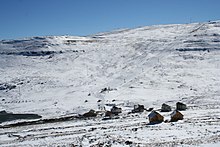User:Cedobbs/sandbox
Geography[edit]

Lesotho covers 30,355 km2 (11,720 sq mi). It is the only independent state in the world that lies entirely above 1,000 metres (3,281 ft) in elevation. Its lowest point of 1,400 metres (4,593 ft) is thus the highest lowest point of any country in the world. Over 80 percent of the country lies above 1,800 metres (5,906 ft). Lesotho is also the southernmost landlocked country in the world and is entirely surrounded by South Africa. It lies between latitudes 28° and 31°S, and longitudes 27° and 30°E.
About 12% of Lesotho is arable land, however, this land is vulnerable to soil erosion, and it is estimated that 40 million tons of soil are lost each year due because of erosion.[1]
Rainfall in Lesotho is highly variable regarding both when and where precipitation occurs. Despite Lesotho's small size, annual precipitation can vary from 500mm annual in one area to 1200mm in another because of elevation.[1] The summer season that stretches from October to April sees the most rainfall, and from December to February, the majority of the country receives over 100mm of rain a month.[1] The least monthly rainfall in Lesotho occurs in June when most regions receive less than 15mm a month.[1]
Climate[edit]
Because of its elevation, Lesotho remains cooler throughout the year than other regions at the same latitude. Most of the rain falls as summer thunderstorms. Maseru and surrounding lowlands often reach 30 °C (86 °F) in summer. Winters can be cold with the lowlands getting down to −7 °C (19 °F) and the highlands to −18 °C (0 °F) at times. Snow is common in the highlands between May and September; the higher peaks can experience snowfalls year-round.
Drought[edit]
Periodic droughts have a serious effect on Lesotho's majority rural population as many people living outside of urban areas rely on subsistence farming or small scale agriculture as their primary source of income.[2] Droughts in Lesotho are exacerbated by poor agricultural practices as well as high rates of HIV/AIDS.[3] The World Fact Books goes as far as to list periodic droughts under the 'Natural Hazard' section of Lesotho's section of the publication.[4]
In 2007, Lesotho experienced its worst drought in 30 years and was advised by the United Nations to declare a state of emergency to get aid from international organizations.[3] Erratic weather and the corresponding decline of the humanitarian situation still present Lesotho with problems currently. The Famine Early Warning System Network most recently reported that the rainy season of 2018/2019 not only started a month later than normal but also has recorded below-average amounts of rain.[5] Also, data from the Climate Hazards Group InfraRed Precipitation with Station (CHIRP) shows rainfall in Lesotho between October 2018 and February of 2019 ranged from 55% to 80% below normal rates.[5]
In March of 2019, the Lesotho Vulnerability Assessment and Analysis Committee conducted a report that initially predicted that 487,857 people in the country need humanitarian assistance because of the effects of drought.[5]
There are a variety of different ways drought in Lesotho has led to the need for humanitarian assistance. Poor hygiene practices that result from a lack of clean water can cause cases of typhoid and diarrhea.[3] Lack of available water also indirectly leads to an increased risk for women and girls who collect water for household consumption as they must spend more time and travel long distances while running the risk of physically or sexually assaulted.[5] Drought in Lesotho also leads to both migration to more urban areas and immigration to South Africa for new opportunities and to escape food insecurity.[3]
The report also found that between July of 2019 and June of 2020 640,000 people in Lesotho are expected to be affected by food insecurity as a result of unproductive harvests as well as the corresponding rise in food prices because of the drought.[5]
 | This is a user sandbox of Cedobbs. You can use it for testing or practicing edits. This is not the sandbox where you should draft your assigned article for a dashboard.wikiedu.org course. To find the right sandbox for your assignment, visit your Dashboard course page and follow the Sandbox Draft link for your assigned article in the My Articles section. |
- ^ a b c d "Lesotho Meteorological Services". www.lesmet.org.ls. Retrieved 2019-11-23.
- ^ Elgoni, A. G.; Ntsike, M.; Matji, M. (1997). "Quality of Life under Drought Conditions. A Case Study of Children in Lesotho". Quality of Life Research. 6 (5): 456–456. ISSN 0962-9343.
- ^ a b c d "LESOTHO: Severe Drought". Africa Research Bulletin: Economic, Financial and Technical Series. 44 (6): 17436A–17436C. 2007. doi:10.1111/j.1467-6346.2007.01037.x. ISSN 1467-6346.
- ^ "Africa :: Lesotho — The World Factbook - Central Intelligence Agency". www.cia.gov. Retrieved 2019-11-23.
- ^ a b c d e "Lesotho: Drought Situation Update 01 (as of 2 May 2019) - Lesotho". ReliefWeb. Retrieved 2019-11-23.
